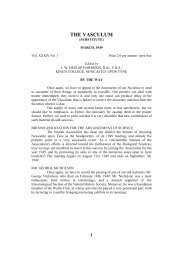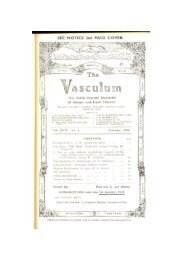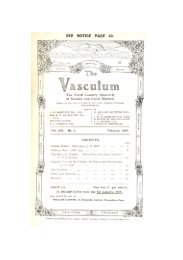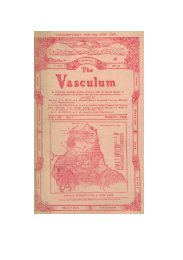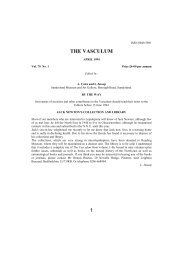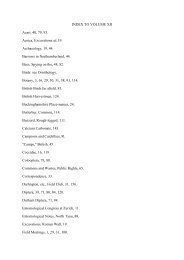1972 - The Vasculum
1972 - The Vasculum
1972 - The Vasculum
You also want an ePaper? Increase the reach of your titles
YUMPU automatically turns print PDFs into web optimized ePapers that Google loves.
47<br />
VASCULUM VOL. LVII. No. 3. <strong>1972</strong><br />
diapause. In addition the rate of larval growth with temperature follows an almost identical relationship to that<br />
shown by Agabus bipustulatus which suggests an overwintering larva.<br />
Of the remaining two species of Agabus found in the tarn Agabus chalconatus was only identified<br />
from nine males, no females having been captured; both this species and Agabus sturmii are locally common<br />
throughout Britain. <strong>The</strong> larvae of the latter were captured regularly in the tarn and overwintered at much the same<br />
time as Agabus bipustulatus. Although adults of this species never laid eggs in the laboratory, suggesting either<br />
adult diapause or the absence of the correct substrate for oviposition, it appears likely that there would be diapause<br />
in the third larval instar. This species is smaller than Agabus bipustulatus and the larval size ranges do not not<br />
overlap which in itself will prevent competition for similar sized prey.<br />
It is interesting to note how the group of closely related species occurring in the same water body<br />
regulate their life histories differently by spatial separation of larvae between plankton and substrate, in size<br />
difference, or in the season when present.<br />
<strong>The</strong> remaining species include Rhantus bistriatus, described by Galewski (1963) as being the most<br />
typical representative of the genus occurring in shallow impermanent sedge or grass choked ponds.<br />
Trichoptera<br />
All the Limnophilus spp. of caddis occurring in the tarn have long adult flight periods and according to Crichton<br />
(1971) these species are all likely to exhibit adult diapause in that no oviposition takes place until late in the<br />
season. In addition P. Hiley (personal communication) states that these species eventually deposit their eggs on<br />
dry stones below top water level and the larvae begin to develop in the egg mass, but then remain inactive until<br />
they are covered by the returning water surface.<br />
Phrygranea grandis, which occurred regularly in the south-east end of the tarn has a flight period from late April<br />
to early July and not only do adults require to deposit eggs into water but also larvae are found throughout the<br />
year, according to Bray R. B. (1969). This species is apparently unsuited to life in all but the perennial parts of the<br />
tarn and is likely to have been eliminated in the catastrophic drying of 1971.<br />
Hydracarina<br />
<strong>The</strong> five species occurring in sorne numbers in the tarn are Arrenurus buccinator, Arrenurus membranator,<br />
Limnesia koenike, Piona coccinea, and Pionacercus leukarti, According tol C. L. Hopkins (1962) these are all<br />
species of thick vegetation in small ponds or reedswarnp. In Tarn Dub the first three species occur in all months of<br />
the year whilst the last two are present from March to September only.<br />
Hirundinea<br />
Of the two species of leech present Erpobdella octoculata dominates. Surveys by K. H. Mann (1955) suggest that<br />
smaller water bodies with calcium contents below 7mg/litre are usually inhabited by a leech population in which<br />
Erpobdella octoculata dominates Helobdella stagnalis<br />
Mollusca<br />
<strong>The</strong> Gasteropod fauna of the tarn is typical of the soft water "slum" fauna described by Boycott (1936). Limnaea<br />
truncatula and Planorbis spirorbis being typical of areas that dry up in summer, whilst Limnaea glabra is a<br />
calcifuge and Planorbis leavis is an inhabitant of soft water areas.<br />
Summary<br />
Elements of the fauna, flora and water chemistry of Tarn Dub, an upland pond subjected to periodic drying out,<br />
are described. <strong>The</strong> species list for the area



